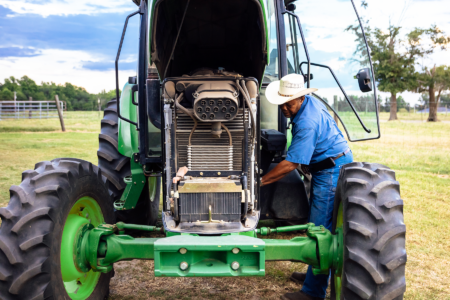When it comes to self-sufficiency, the more you can do for yourself, the more money you’ll save. This is especially true for maintaining your property’s equipment and machinery. Because the tractor is a heavily used piece of machinery, it’s a great place to start realizing basic tractor maintenance yourself. This post is not intended to be all-inclusive in its coverage of basic tractor maintenance; it merely attempts to point out some of the primary areas of consideration for maintaining your tractor.
Tractor Fuel, Oil, Filters, Battery, Tires, and Brake Maintenance
The fuel. When the tractor’s been stored for more thana few months, it is a good idea to replace its old fuel with new. New fuel ensures a quality grade of fuel, without water buildup. Water buildup often results from condensation. This water buildup can accumulate and be distributed through the fuel lines. Water in the fuel lines can then be introduced into the engine, compromising the engine or its performance.
The oil. The tractor’s oil should be changed regularly, usually at 100-hour intervals, after a period of heavy use, or in particularly dusty operating conditions. Check the manufacturer’s maintenance manual for the specific type of engine oil to be used.
Changing the oil. To change the oil, make sure the tractor is securely parked and free of movement. Place a large oil drip pan beneath the tractor’s oil reservoir. Remove the plug screw. Allow the old oil to drain down into the drip pan. After the oil chamber has fully drained, replace and check the security of the plug screw. Open the oil refill cap, insert a funnel down into the oil chamber, and refill with the recommended amount of new oil.
Fuel filter. Since the tractor has been refilled with clean oil and maintenance is underway, it makes sense to change the engine oil and oil filters simultaneously. Changing or cleaning the filters prevents any old dirt, dust, and debris from being introduced into the new oil or the engine. You may be able to wash and clean the filters yourself if they’re not too dirty or deteriorated.
Battery. Inspect and clean the battery terminals. Check the battery’s terminals for rust, cracks, corrosion, or grease residue. When the tractor sits for extended periods without operating, the battery can discharge. As the battery discharges, it can weaken and overtax the alternator.
Tires. Check the tires’ overall integrity, making sure that they’re not split, worn, or cracked. Check that the tires’ tread depth and air pressure is adequate for proper performance. If you find the tires are in poor condition, consider getting one or more good replacements.
Brakes. Follow these instructions for replacing tractor brakes.
- Raise and secure the tractor. If necessary, take off the rear wheels to provide easier access to the brakes.
- Take off the break linkage by unhooking it from its cam. Take the bolts off the cover.
- To take any pressure off the brake shoes, make sure the brake cam is in neutral.
- Using a flathead screwdriver or other prying tool, carefully pry off the cover. Be careful not to break or bend the cover. Remove the shoes, brake cam, and O-ring.
- Before replacing the parts, make sure to clean any dirt and buildup from the brake cam and its cover. This will prevent contamination with these substances on the reinstalled parts.
- To prevent excessive wear & tear on the brake shoes from the brake drum, make sure that no rust or debris is on the brake drum. If so, sand drum until smooth and clean.
- Install new brake shoes, O-ring, and, if needed, new springs. Ensure brake cam is fully lubricated.
- For moisture and rust prevention, add a new gasket.
- Replace any remaining parts, plus the bolts, linkage, and cover. Lastly, replace the rear wheels.
- Check and adjust the brake pedal, if needed.
Tractor Belts, Blades, and Body
Belts. Like tires, check the overall integrity of the belts, and ensure there are no cracks, splits, or tears. Check that the drive belt is in good condition. You may want to observe the drive belt with the engine running. This will allow you to check that the belt is properly aligned around the fly wheel. The tractor relies on the belts to drive power to all of its internal functions.
Blades. Check the security of the blades. Make sure there are no loose nuts, bolts, or screws. Once satisfied that everything is secured properly, you may then remove and sharpen the blades. With a sandstone or grinding wheel, sharpen the blades as necessary. Oil and properly replace and secure the blades back on the tractor.
Body. Finally, regularly inspect for rust on the body of the tractor. Rust breaks down and weakens the integrity of the metal. For rust prevention, conduct a thorough (topside and underside of tractor) body inspection. If you observe any rust, sand, smooth, and paint the affected area.
Monica White is a freelance writer, member of the Georgia Air National Guard, and an avid runner and cyclist who loves the great outdoors and all things DIY. She divides her time between Tampa and her central Florida property, where she’s growing a self-sufficient homestead. Connect with Monica on her outdoor lifestyle blog, on Facebook, Twitter and Instagram. Read all of her MOTHER EARTH NEWS posts here.
All MOTHER EARTH NEWS community bloggers have agreed to follow our Blogging Guidelines, and they are responsible for the accuracy of their posts.







